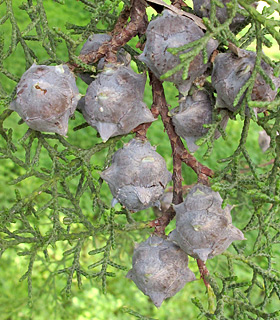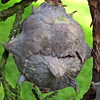Cupressus lusitanica, is a species of cypress native to Mexico and Central America. The [Latin] name derives from the fact that the species was introduced to Lusitania, Portugal, in the 17th century. Lusitania was an ancient Roman province including approximately all of modern Portugal south of the Douro river and part of modern Spain.
This species occurs on various usually nutrient-poor rocky soils over limestone or various igneous rocks; it is also spreading in scrub on rocky slopes or cliffs in canyons. The altitudinal range of this species is from ca. 1000 m to nearly 4000 m a.s.l. Some trees in the mountains of Guatemala exceed 2m dbh and are nearly 60m tall.
Cupressus lusitanica has been planted widely for commercial production: at high altitudes in Colombia (3300 m), Bolivia and South Africa, and near sea level in New Zealand where is fully naturalized. In Colombia trees are planted to form windbreak curtains and for fighting soil erosion on slopes. It has been planted as an ornamental tree near sea level in temperate climates and has done very well: Portugal, Argentina, Texas and the British Isles where it can reach a height of 30 m.
Cupressus lusitanica is an evergreen conifer tree growing to 40 m tall, with a crown pyramidal in young trees, flat-topped in older ones; branches spreading or ascending, ends often drooping. The foliage grows in dense sprays, dark green to somewhat yellow-green in colour. The leaves are scale-like, ovate, closely pressed, usually with long, pointed apex 2–5 mm long, and produced on rounded (not flattened) shoots. The outer bark of young trees smooth, orange-brown to red-brown, becoming vertically grooved, grey and exfoliating in large strips with age.
Male cones appear to be fat tips to branchlets and produce clouds of yellow pollen. Female cones globose, ca. 12 mm across, blue-green in the juvenile stage, turning dark brown when they ripen about 25 months after pollination, composed of 6-8 scales with a central strong, reflexed umbo, erect on the upper scales. Seeds about 75 to a cone, brown, with resin glands, about 4 mm long together with a narrow wing. The cones may either open at maturity to release the seeds, or remain closed for several years, only opening after the parent tree is killed in a wildfire, allowing the seeds to colonize the bare ground exposed by the fire. Pinus halepensis seeds behave in a similar way.
Cupressus lusitanica is found in seasonally moist to permanently moist climates, with annual precipitation typically between 1000 and 1500 mm and a dry season lasting not more than 2-3 months. It also occurs in very moist climates with annual precipitation up to 4000 mm. It is not generally damaged by occasional snow or brief periods of frost, but there are significant differences in this among provenances. It cannot withstand waterlogging, and flourishes in deep, moist, well-drained, fertile loams of neutral to slightly acidic reaction.
There are two varieties, treated as distinct species by some botanists:
Cupressus lusitanica var. lusitanica (syn. C. lindleyi) - Mexican Cypress - Foliage in three-dimensional sprays, with small shoots in two planes. Occurs in lower rainfall areas has a wide distribution from the Sierra Madre Occidental in Mexico south as far as Nicaragua. (IUCN-Least concern species)
Cupressus lusitanica var. benthamii (syn. C. benthamii) - Bentham's Cypress - Foliage in flattened sprays, with small shoots all in one plane. Occurs in higher rainfall areas in southern Mexico. (IUCN-Near Threatened species)
Conventionally, C. lusitanica is raised from seed, although it is possible to induce root cuttings. Presowing treatment is not necessary. For rapid and uniform epigeal germination, stratification in damp sand for 30 days is recommended; germination takes place in 20-30 days; expected germination rate is 30-45% from mature, healthy seed lots. Seedlings grown in raised beds are 5-7 cm tall in about a week, when they should be transferred into containers filled with soil of good drainage.
Cupressus lusitanica was one of the first New World conifers to be brought home to Europe, having been planted in Portugal since 1634 and in England since 1682. It has since become the most horticulturally important of the tropical cypresses, widely introduced in South America, Africa, Asia and elsewhere. Fast-growing and drought tolerant, Cupressus lusitanica has been introduced from Mexico's provenances to different parts of the world. Cupressus lusitanica produces poles at 10 years after planting, and general purpose timber after 20 years. It is widely cultivated, both as an ornamental tree and for timber production, in warm, temperate and subtropical regions around the world.
In Costa Rica, Cupressus lusitanica is the most popular Christmas tree. It also is very popular in the city parks and is often used as a living fence because of the very dense branches it develops. This is commercially harvested as a timber tree in both Mexico and Guatemala and produces a fine, straight-grained lumber. The wood is used for construction, furniture, poles and posts. It is also suitable for light flooring, ship and boat building, vehicle bodies, agricultural implements, boxes and crates, interior trim, joinery, toys and novelties, turnery, draining boards, veneer and plywood, hardboard and particle board. The wood is used for paper making, and it is good firewood. Freshly sawn wood has a faint cedar-like scent.
Essential oil from the leaves, twigs and branches of the tree is used as an adjuvant and perfume in soaps, room sprays, deodorants and other products. It is also used in the treatment of rheumatism, whooping cough and as a styptic. The vapor from a leaf decoction is inhaled several times a day for treatment of flu. Some ethnic groups in Mexico use the leaves against cancer. In Cameroon the leaf juice is used to cure skin diseases and the leaves are used to protect stored grain from insects.
The Cupressaceae family includes 7 sub-families, 27-30 genera, and 130-140 species. The tallest and largest plants of the world, Sequoia sempervirens, commonly known as “redwood”, and Sequoiadendron giganteum, commonly known as the "giant sequoia". Cupressus is one of the genera in the Cupressoideae sub-family, it includes 29 species 18 of which are native to America, and the others are from the old world.
In the Bible Cupressus (Brosh) is mentioned twenty times, mostly as timber brought together with the Cedars of Lebanon. Therefore some investigators maintain that those are reference to Abies cilicica which grows even today in the mountains of Lebanon, rather than to Mideastern Cupressus sempervirens, which we call by that name today.
The Cupressus lusitanica trees planted in Israel are from the drought resistant Mexican stock, which survive with no irrigation in our area. It is a rare species that is being planted more coonly in recent years because it is resistant to the pathogenic fungus that attacks the common cypress, Cupressus sempervirens. A nice specimen which was planted during the British Mandate period can be seen in Sh’aar Ha’gai on the northen slope near the three pyramidal cypress trees.
Written by Amram Eshel and Zvi Avni






